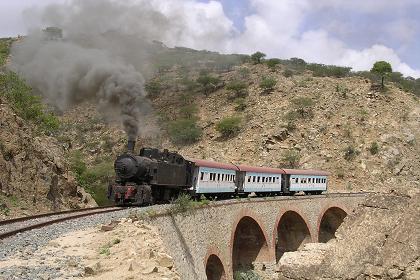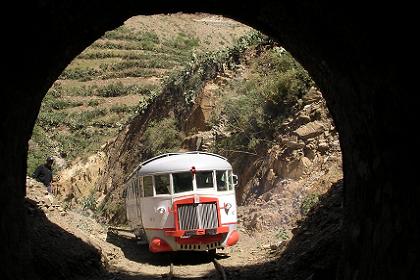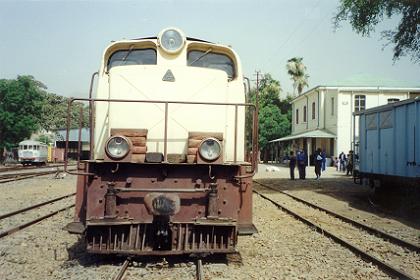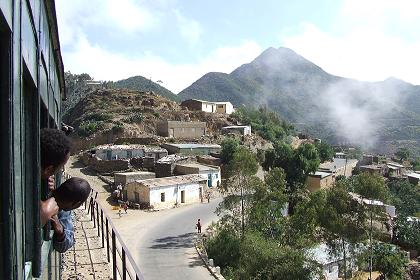Map of Eritrea
Location and geography
Eritrean history
Border conflict with Ethiopia
Political structure
Eritrean anthem
Economy & currency
Climate
People
Languages
Religion
Health care
Transport
Cuisine
News, links, books and more
Asmara (Asmera)
Agordat (Akordat)
Assab (Asseb)
Barentu
Dahlak islands
Dekemhare (Decemhare)
Ghinda (Ginda)
Keren (Cheren)
Massawa (Massauwa)
Mendefera (Adi Ugri)
Nakfa (Nacfa)
Semenawi Bahri (Filfil)
Tessenei
(Teseney)
The Eritrean Railway
The construction of the narrow-gauge railway line was begun in Autumn of 1887 by the Italians to provide supply routes to the advanced army positions, as well as the transportation of raw materials intended to be mined in Eritrea. The line reached Asmara in December 1911 and the Agordat terminus in 1928. It was originally intended to continue the line to Tesseney and beyond and rails were laid as far as Bisha (31 kms from Agordat). Engineering studies and drawings were completed up to Ellit. The system had originally been planned to link up to the rail networks in Ethiopia and Sudan.
The trains, surplus material of Italian origin, serviced 30 stations, took 1548 curves, and were plunging in and out 39 tunnels, passing 65 bridges and viaducts. 38 trains were running in 24 hours in each direction on the Asmara - Massawa line. The historic railway covered 306.4 kms on a route from the port of Massawa to Agordat via Asmara and Keren.
Its route ascends from the coastal plain at sea level, clinging tightly to the edge of the steep escarpment before reaching the Asmara plateau at 2394 meters above sea level and then descending to an altitude of 650 meters to the Barka lowlands in Agordat. This sharp increase and decrease in altitude within a short distance, the beautiful scenery it crosses, and the artistically built bridges and tunnels makes the line uniquely spectacular.
The line opened new markets for farm products, and towns such as Nefasit, Keren and Agordat prospered. The railway system was the largest employer, had well equipped workshops and garages, an efficient and effective communication network confirmed by its accident-free handling of traffic throughout its history.
It had been deteriorating due to the negligence of the Ethiopian administration. The railway stopped its operation in 1975 during the war of liberation, when Ethiopian forces destroyed the railway, tore up its iron rails to build fortifications, workshops were dismantled and plundered, and its rolling stock was left to dilapidation. and finally was closed in 1976. Steel sleepers salvaged from the railway were re-used as fences.
After 20 years of destruction, despite other priorities, the government of Eritrea launched a project to rehabilitate the railway system in May 1994, after rejecting a proposal by foreign consultants to refurbish the railway for US$ 400 million, in a spirit of self reliance.
The project that started on the basis of domestic skills and veteran railroad workers, many in their 80s, not only comprises recovering the track, but also rebuilding the workshops, garages and stations, and the restoration of the Fiat Littorina railcars, two 1957 Krupp Bo-Bo diesels, locomotives and rolling stock.
The service between Massawa and Ghinda resumed in 1996 and the Massawa - Asmara line was completed in February 2003. The stretch between Nefasit and Asmara is the most remarkable. With over 20 tunnels, 65 bridges and viaducts and an incline of 1:30 this section is a triumph of Italian engineering, and now a symbol of national pride and self-reliance.
It is a fascinating experience to enjoy the marvelous authentic 1930s vintage Mallet steam locomotive or Littorina railcar ride run by senior operators, older than the locomotives themselves. It is one of the most tortuous mountain railways on earth, through a picturesque scenery, tunnels and bridges, that make the line spectacular and one of the best tourist sights in the world.
At present the Eritrean railway service has started providing customized tour service to tourist, using restored steam and diesel trains and rolling stock. It takes six hours from Massawa at sea level up to 2,400 meter above sea level in Asmara at an average speed of 19 kilometers (12 miles) an hour up the escarpment. Eritrean Railway offers charter services, and provides round trip services from Asmara to Nefasit and Arberebu on Sundays (departure time 8:00 AM)
Eritrean Railways
Tel +291 1 123365 / 201784
Fax +291 1 201785Asmara Grande Travel Agency
Tel +291 1 110672
www.asmaragrande.com



